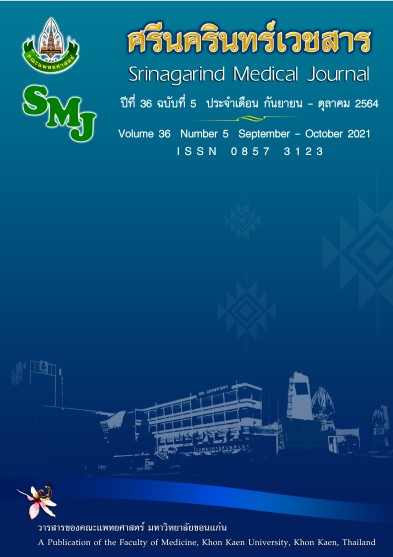Compliance of Iron Supplementation During Pregnancy
Keywords:
iron supplementation; compliance; side-effects; pregnancyAbstract
Background and objectives: This study aimed to determine the compliance rate of iron supplementation and the hemoglobin concentration in second trimester and at term of pregnant women to take into consideration for the optimal practice.
Methods: The study conducted among term pregnant women admission to the hospital for delivery who had non-anemic status at the initial visit for antenatal care, received daily iron supplementation before 20 weeks of gestation. They were interviewed to obtain the personal data, daily taking the supplemented tablet and side-effects. The compliance rate categorized as >80%, >50-80%, 25-50%, and < 25% according to the women’s response that they took daily tablet of 6-7, 3-5, 2, and 0-1 day(s) in one week, respectively. The laboratory results of hemoglobin level were retrieved from their medical records.
Results: Among 350 participants had the compliance rate of >80%. The common side-effects were nausea and constipation. The side-effect rates were 10.5%, 12.1%, 66.7% in >80%, >50-80%, <25% compliance groups, respectively. While hemoglobin concentrations above 13 gm/dl, which defined as high concentrated hemoglobin, revealed 12% during second trimester, and up to 30% at term in high compliance group.
Conclusions: The pregnant women had compliance rate greater than 80% of taking iron supplementation 6-7 tablet/week.
References
2. Lee AI, Okam MM. Anemia in pregnancy. Hematol Oncol Clin North Am 2011; 25(2): 241–259, vii.
3. Auerbach M, Abernathy J, Juul S, Short V, Derman R. Prevalence of iron deficiency in first trimester, nonanemic pregnant women. J Matern Fetal Neonatal Med 2021; 34(6): 1002-1005.
4. Casey GJ, Montresor A, Cavalli-Sforza LT, Thu H, Phu LB, Tinh TT, et al. Elimination of iron deficiency anemia and soil transmitted helminth infection: evidence from a fifty-four month iron-folic acid and de-worming program. PLoSNegl Trop Dis 2013; 7(4): e2146.
5. VanderMeulen H, Strauss R, Lin Y, McLeod A, Barrett J, Sholzberg M, et al. The contribution of iron deficiency to the risk of peripartum transfusion: a retrospective case control study. BMC Pregnancy Childbirth 2020; 20(1): 196.
6. Athe R, Dwivedi R, Pati S, Mazumder A, Banset U. Meta-analysis approach on iron fortification and its effect on pregnancy and its outcome through randomized, controlled trials. J Fam Med Prim Care 2020; 9(2): 513–519.
7. Col Madendag I, EraslanSahin M, Madendag Y, Sahin E, Demir MB, Acmaz B, et al. The effect of iron deficiency anemia early in the third trimester on small for gestational age and birth weight: a retrospective cohort study on iron deficiency anemia and fetal weight. BioMed Res Int 2019; 2019: 7613868.
8. Stevens GA, Finucane MM, De-Regil LM, Paciorek CJ, Flaxman SR, Branca F, et al. Global, regional, and national trends in haemoglobin concentration and prevalence of total and severe anaemia in children and pregnant and non-pregnant women for 1995-2011: a systematic analysis of population-representative data. Lancet Glob Health 2013; 1(1): e16-25.
9. Kavle JA, Stoltzfus RJ, Witter F, Tielsch JM, Khalfan SS, Caulfield LE. Association between anaemia during pregnancy and blood loss at and after delivery among women with vaginal births in Pemba Island, Zanzibar, Tanzania. J Health Popul Nutr 2008; 26(2): 232–240.
10. Agbozo F, Abubakari A, Der J, Jahn A. Maternal dietary intakes, red blood cell indices and risk for anemia in the first, second and third trimesters of pregnancy and at predelivery. Nutrients 2020; 12(3): 777.
11. Peña-Rosas JP, De-Regil LM, Garcia-Casal MN, Dowswell T. Daily oral iron supplementation during pregnancy. Cochrane Database Syst Rev 2015 22; (7): CD004736.
12. Tolkien Z, Stecher L, Mander AP, Pereira DIA, Powell JJ. Ferrous sulfate supplementation causes significant gastrointestinal side-effects in adults: a systematic review and meta-analysis. PloS One 2015; 10(2): e0117383.
13. WHO | WHO recommendations on antenatal care for a positive pregnancy experience [Internet]. WHO. [cited Aug 9, 2020]. Available from: http://www.who.int/reproductivehealth/publications/maternal_perinatal_health/anc-positive-pregnancy-experience/en/
14. Ugwu EO, Olibe AO, Obi SN, Ugwu AO. Determinants of compliance to iron supplementation among pregnant women in Enugu, Southeastern Nigeria. Niger J Clin Pract 2014; 17(5): 608-612.
15. Habib F, Alabdin EHZ, Alenazy M, Nooh R. Compliance to iron supplementation during pregnancy. J ObstetGynaecol J Inst ObstetGynaecol 2009; 29(6): 487–492.
16. Sendeku FW, Azeze GG, Fenta SL. Adherence to iron-folic acid supplementation among pregnant women in Ethiopia: a systematic review and meta-analysis. BMC Pregnancy Childbirth 2020; 20(1): 138.
17. Birhanu TM, Birarra MK, Mekonnen FA. Compliance to iron and folic acid supplementation in pregnancy, Northwest Ethiopia. BMC Res Notes 2018; 11(1): 345.
18. Taye B, Abeje G, Mekonen A. Factors associated with compliance of prenatal iron folate supplementation among women in Mecha district, Western Amhara: a cross-sectional study. Pan Afr Med J 2015; 20: 43.
19. Gebremedhin S, Samuel A, Mamo G, Moges T, Assefa T. Coverage, compliance and factors associated with utilization of iron supplementation during pregnancy in eight rural districts of Ethiopia: a cross-sectional study. BMC Public Health 2014; 14: 607.
20. Yip R. Significance of an abnormally low or high hemoglobin concentration during pregnancy: special consideration of iron nutrition. Am J Clin Nutr 2000; 72(1 Suppl): 272S–279S.
21. Alizadeh L, Salehi L. Is routine iron supplementation necessary in pregnant women with high hemoglobin? Iran Red Crescent Med J 2016; 18(1): e22761.
22. Young MF, Oaks BM, Tandon S, Martorell R, Dewey KG, Wendt AS. Maternal hemoglobin concentrations across pregnancy and maternal and child health: a systematic review and meta‐analysis. Ann N Y Acad Sci 2019; 1450(1): 47–68.
23. Steer PJ. Maternal hemoglobin concentration and birth weight. Am J Clin Nutr 2000; 71(5): 1285S–1287S.
24. Murphy JF, O’Riordan J, Newcombe RG, Coles EC, Pearson JF. Relation of haemoglobin levels in first and second trimesters to outcome of pregnancy. Lancet Lond Engl 1986; 1(8488): 992–995.




